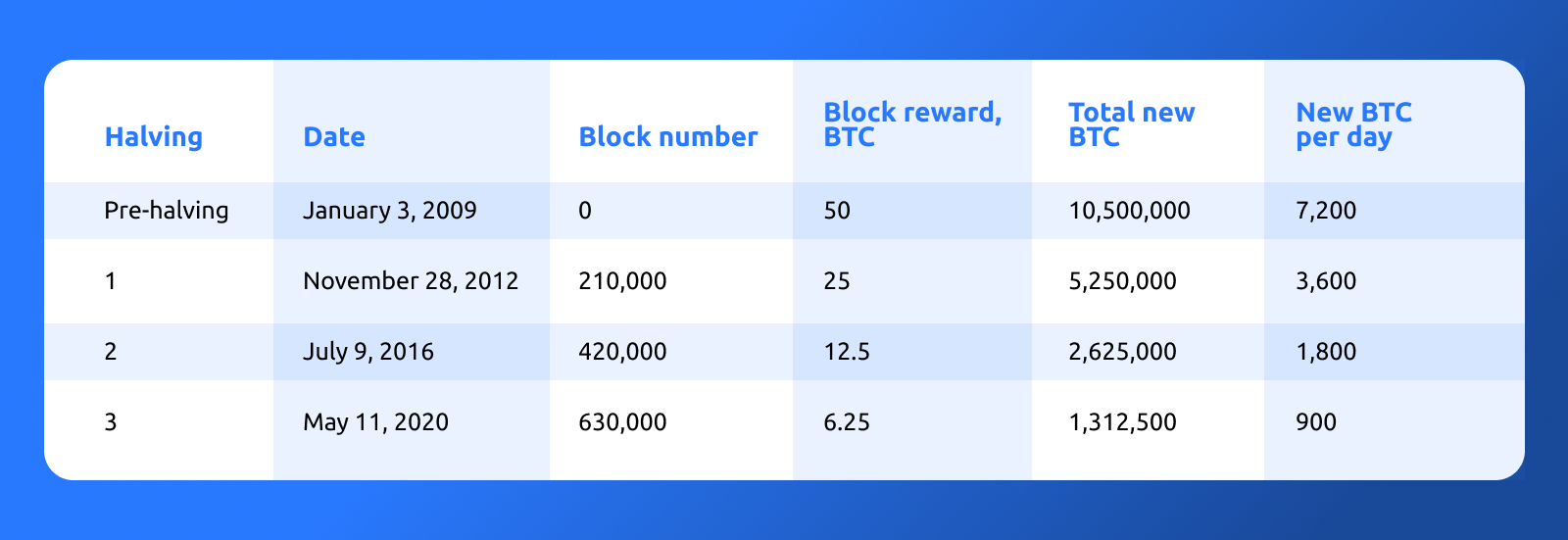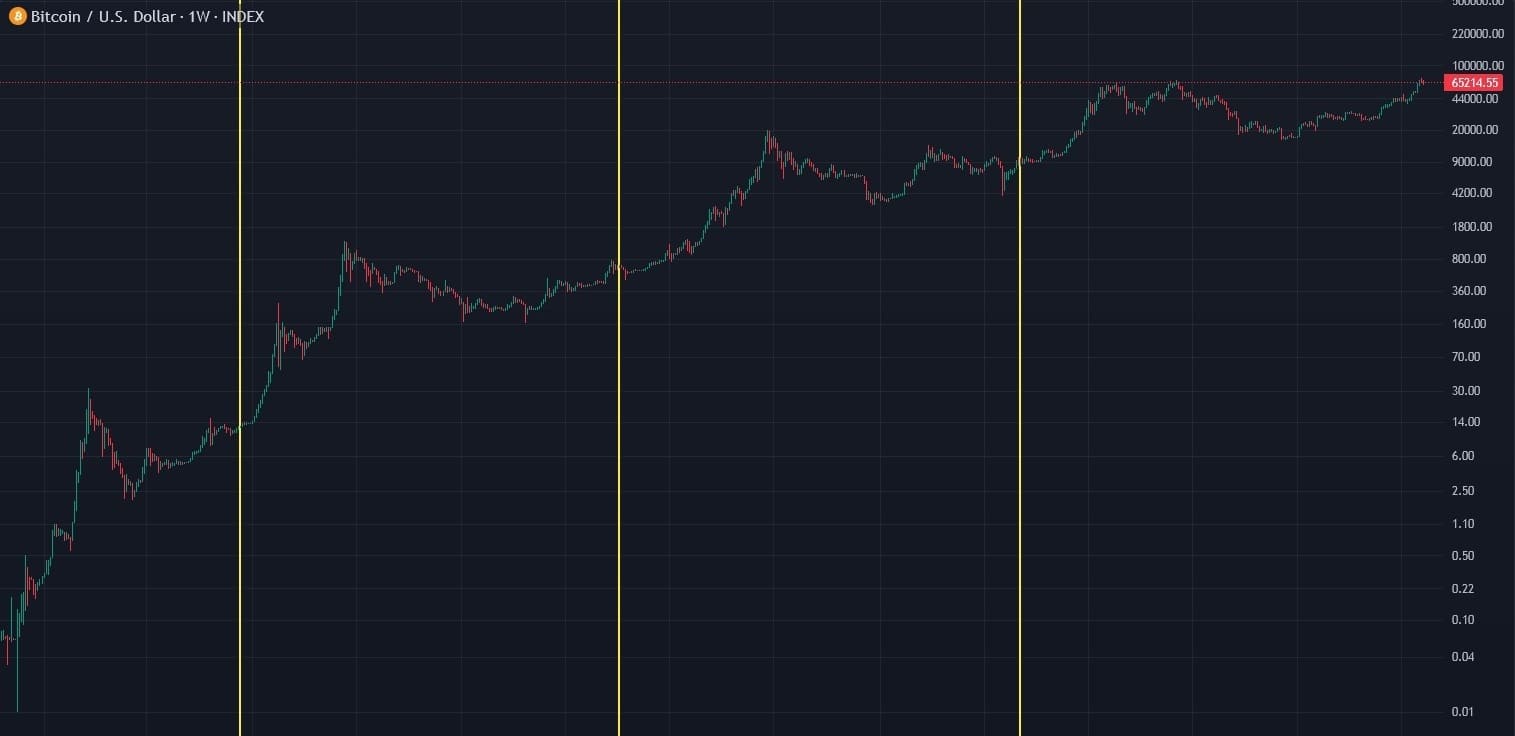Next Bitcoin Halving 2024

Next Bitcoin Halving 2024: How It Works, History, and Will Bitcoin Go Up After Halving 2024?
With the countdown to Bitcoin halving 2024 underway, the crypto community is buzzing with anticipation and speculation. In this article, we'll unravel the intricacies of Bitcoin's supply mechanism, examine the historical patterns of previous halvings, and assess if Bitcoin's price is likely to surge following the upcoming 2024 halving.
What is Bitcoin halving?
Bitcoin halving is a highly anticipated event in the cryptocurrency world that occurs approximately every four years. It is a programmed event in the Bitcoin protocol where the reward for mining new blocks is halved.
Bitcoin mining is the process by which new bitcoins are created and transactions are verified and added to the blockchain – a decentralized ledger that records all Bitcoin transactions. All verified transactions are grouped together into blocks. Miners are hardware devices that compete to solve complex mathematical puzzles (people who mine crypto are also called miners). These puzzles are part of the process of verifying and adding transactions to the blockchain. The miner who successfully solves the puzzle and adds the block to the blockchain is rewarded with newly created bitcoins, as well as transaction fees paid by users who sent Bitcoin transactions.
After every 210,000 blocks mined, which is approximately every four years, the reward for mining new blocks is halved. This reduction in block rewards leads to a decrease in the rate at which new bitcoins are generated. When Bitcoin was first created, the block reward for miners was 50 bitcoins per block. However, after the first halving event in 2012, this reward was reduced to 25 bitcoins. Subsequent halving events further reduced the block reward.
Why does Bitcoin halve?
But why was the Bitcoin block reward halving implemented in the first place? Well, it's a rather elegant approach that solves several issues at once:
- Inflation control and scarcity. Bitcoin's creator, Satoshi Nakamoto, designed it to have a maximum supply of 21 million bitcoins. By halving the Bitcoin block reward approximately every four years, the rate at which new bitcoins are introduced into circulation gradually decreases. The reduction of rate at which new bitcoins are created contribute to the overall scarcity of Bitcoin. This scarcity is a fundamental aspect of Bitcoin's value proposition, akin to precious metals like gold.

- Incentivizing miners. Initially, when Bitcoin was still in its infancy and relatively obscure, the substantial block reward served as an incentive for miners to participate in the Bitcoin network. The gradual decrease in the block reward incentivizes miners to continue to keep the Bitcoin network running and adapt to changes in rewards.
- Initial coin distribution and inflation balancing. The gradual reduction of the block reward allowed for the initial distribution of a notable portion of the coins while new bitcoins keep being distributed for a long time to come.
Bitcoin's halving mechanism is a key component of its transparent and predictable monetary policy. Unlike traditional fiat currencies, where central banks can adjust money supply at will, Bitcoin's issuance schedule is predetermined and enforced by code.
Bitcoin halving countdown
So when is the next Bitcoin halving? That isn't hard to find out. Many crypto websites and apps have a Bitcoin halving countdown feature. It's a timer or countdown clock that tracks the estimated time remaining until the next scheduled Bitcoin halving event. Such countdowns are used by members of the cryptocurrency community, investors, miners, and enthusiasts to anticipate and prepare for the upcoming halving event.
Bitcoin halving dates history
There are expected to be a total of 33 Bitcoin halving events. As a result of these halvings, the fixed portion of the block reward will gradually decrease until it reaches less than 1 satoshi, which is the smallest unit of Bitcoin. This reduction will effectively bring the fixed portion of the block reward to zero, which will mean the completion of Bitcoin's issuance schedule and reaching its maximum supply. This final 33rd halving should occur approximately around 2140.

Pre-halving period
Bitcoin was launched on January 3, 2009. The initial block reward was set at 50 BTC. At that time, Bitcoin held little to no monetary value, resulting in minimal incentive for individuals to engage in mining. However, the landscape began to shift on March 17, 2010, when BitcoinMarket.com emerged as the first Bitcoin exchange. This development sparked notable interest in the nascent cryptocurrency. Despite the fact that half of the total available Bitcoins were mined during this relatively brief period before the first halving, the price of Bitcoin experienced remarkable growth during this phase.
BTC price at the start of the period: N/A
BTC price 1 year later: N/A
Bitcoin halving 2012
The first halving marked a significant milestone for Bitcoin. At that time, no one knew for sure what the consequences would be. The event demonstrated the protocol's deflationary nature and increased awareness of Bitcoin's scarcity, leading to speculation about its potential as a store of value.
BTC price at the start of the period: $12
BTC price 1 year later: $964
Bitcoin halving 2016
The second halving event further reduced the block reward by half, from 25 bitcoins to 12.5 bitcoins per block. This halving occurred amidst growing mainstream awareness and adoption of Bitcoin. It fueled speculation and anticipation within the cryptocurrency community, contributing to increased volatility and trading activity.
BTC price at the start of the period: $663
BTC price 1 year later: $2550
Bitcoin halving 2020
The third Bitcoin halving marked another reduction in the block reward, halving it from 12.5 bitcoins to 6.25 bitcoins per block. It took place against the backdrop of global economic uncertainty and heightened interest in Bitcoin as a hedge against inflation. It coincided with the COVID-19 pandemic and central bank stimulus measures, highlighting Bitcoin's role as a decentralized alternative to traditional fiat currencies. The event intensified discussions about Bitcoin's scarcity and its potential to serve as digital gold.
BTC price at the start of the period: $11,950
BTC price 1 year later: $56,413
Bitcoin halving 2024
The fourth halving should occur, by most estimates, around April 20, 2024. It will further reduce the block reward to 3.125 BTC per block. As with previous halvings, it attracts attention from the cryptocurrency community and influences market dynamics and sentiment surrounding Bitcoin.
How does Bitcoin halving affect miners and mining?
The most immediate impact of Bitcoin halving is the reduction in block rewards received by miners. With the reduction in block rewards, mining becomes less lucrative, leading to increased competition among miners to secure a share of the remaining rewards. This heightened competition can result in less efficient miners being priced out of the market, as they struggle to cover their operational costs.
The reduced block reward and subsequent quitting of some miners leads to a decrease in the overall hash rate. In response, the protocol adjusts the difficulty of mining downward. However, the rise in Bitcoin's price eventually offsets the decline in the block reward and subsequently the network's hashrate begins to rise again.
In the long term, as block rewards diminish over time and approach zero, miners will have to
increasingly rely on transaction fees as their primary source of revenue. This shift in revenue composition may impact the sustainability and profitability of mining operations, particularly for miners operating on thin profit margins.
How does halving influence Bitcoin’s price?
Bitcoin Halving events decrease the rate at which new bitcoins are created, thereby reducing the supply growth of the cryptocurrency. However, while the impact of supply reduction was quite noticeable after the first halving, the effect diminished with each subsequent halving. Currently, approximately 93.62% of Bitcoin's maximum supply has been mined, meaning that the further supply growth reduction due to halving is becoming increasingly negligible. In fact, the daily reduction in supply growth from fourth halving will amount to less than 0.1% of the average daily trading volume of Bitcoin.
Nevertheless, the halving events highlight Bitcoin's scarcity and fixed supply schedule, reinforcing its narrative as a deflationary asset similar to gold. This narrative can attract investors seeking assets with limited supply, driving up demand and, consequently, the price of Bitcoin.

Bitcoin halving 2024: BTC price prediction
There's widespread anticipation based on historical trends that the upcoming halving event will once again spark a bullish cycle in the market, propelling Bitcoin to new record highs. However, this time is different from previous times in that Bitcoin has already surpassed the all-time high of the previous cycle, although the fourth halving has yet to occur. Currently, the price of Bitcoin is displaying a distinct upward trend, reflecting growing optimism among investors. While the approaching halving undoubtedly contributes to this positive sentiment, a significant driver of Bitcoin's current growth is the continued influx of funds into Bitcoin spot ETFs as well as the overall increase in Bitcoin adoption.
Considering the excitement surrounding the upcoming halving and the broader economic and political landscape, it is quite possible that Bitcoin's price could surpass the $90,000 threshold in 2024.
Should I buy Bitcoin before halving?
While the probability of Bitcoin's price rising further is quite high, it is by no means guaranteed. Remember that past performance is not indicative of future results. So before investing in Bitcoin, consider your risk tolerance and investment goals. Always do your own research before investing and never invest more than you can afford to lose.

BTC halving giveaway
If you are also looking forward to the upcoming halving, join us in celebrating it with our grand giveaway. Engage in trading with MultiHODL and seize the opportunity to be one of the 200 lucky winners who will share half a Bitcoin!
- The prize pool is over $30,000 and the grand prize is $10,000!
- Each week we are randomly selecting 25 active traders who will win $100 each.
- You have the chance to win in both the weekly draws and the final giveaway.
For more details about the giveaway and the terms and conditions of participation, check out the link.








